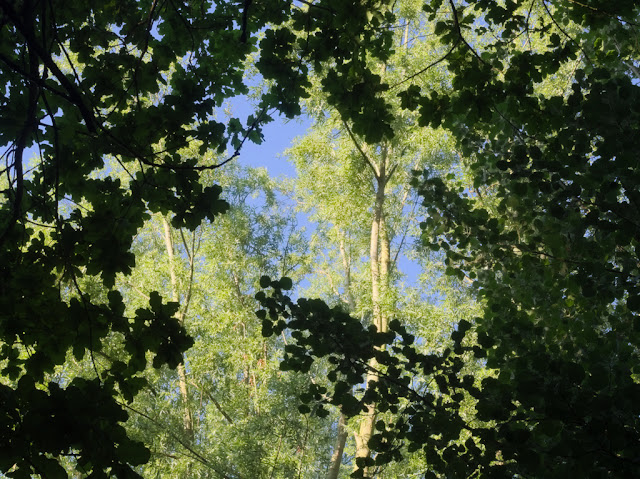 |
| Path at Western Edge of Todd's Pit 17 June 2015 |
The path along the western side of Todd's Pit is typical of many paths in the park. The path is turned almost into a tunnel by the interlocking branches above, from which the bluey green foliage of the willow rises like a plume of smoke. Below there are extremes of light and shade where the sunlight breaks through between the trees.
In the Canopy
 |
| Canopy by Hall's Pond 12 June 2015 |
One aspect of this that I had not fully appreciated until recently, is that each tree has it own bit of sky that is not invaded by the leaves and branches of the surrounding trees. This image, which clearly shows the rivers of sky between the trees, is an image of the personal space of a tree!
 |
| Middle Path 6 June 2015 |
In this photograph the silvery green of willow leaves catching the sunlight contrasts in both colour and shape with the oak and maple leaves of nearer trees that are in the shade.
Going Down
Scroll down this image to follow these trees from the canopy to ground level. |
| Path at Eastern Edge of Dickerson's Pit 17 June 2015 |
I think the most impressive, and probably the tallest, trees in the park line the path alongside the eastern edge of Dickerson's Pit. This photograph of that path just north of the 13th Public Drain at least begins to give some sense of the height of these trees and how they dwarf everything and everybody below. The only way I could get the full length of these trees into a single image was by taking a series of images at different heights and stitching them together.
At Ground Level
 |
| By Dickerson's Pit 30 June 2015 |
Much, much, shorter are these old, ivy encrusted, willow trees bent over an earth bank on the western edge of Dickerson's Pit.
In the Woods
 |
| North of Todd's Pit 30 June 2015 |
Finally, in the woods, the ivy clad tree trunks, some leaning slightly to the right, are like an army trampling over the undergrowth. Totally dominant. It is images like this that remind me why I find something sinister in so many woods.
Next Post
When I started this blog, my major concern was whether or not I could find enough images to populate a post twice a month with at least four images. So far, my fears have been proved totally groundless. Groundless, to the point that at the end of July I still have not finished with spring. Just so that this blog is not so far behind what is happening on the ground, I am going put an extra post of more spring flowers next Saturday. The post after that will then deal with the late June blossoming of elderflower and wild roses, and bring spring to a close.NEXT: AFTER THE MAY FLOWER











